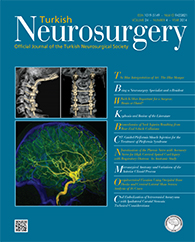2Turgut Ozal University, School of Medicine, Department of Neurosurgery, Ankara, Turkey
3Okayama University, Graduate School of Medicine and Dentistry, Department of Molecular Biology and Biochemistry, Okayama, Japan
4Turgut Ozal University, School of Medicine, Department of Medical Biology, Ankara, Turkey DOI : 10.5137/1019-5149.JTN.9043-13.2 AIM: Astrocytes and extracellular matrix molecules have important roles in regulating synaptic functions between neurons in the central nervous system. However, under pathological conditions, these constituents are activated to form glial scar that is thought to be harmful for neuronal regeneration. The aim of this study was to evaluate the expression pattern of ADAMTS1, -4, -5 and -9 in IL-1 stimulated astrocyte cultures obtained from postnatal day zero mouse brains.
MATERIAL and METHODS: Real time PCR analyses were performed.
RESULTS: An overexpression of ADAMTS1, -4, -5 and -9 at the 3-h time point after IL-1 stimulation was found. IL-1 stimulation induced aggrecaneses and this effect was time dependent. Maximum increase was detected at 3-h (six fold increase). Interestingly the expression of ADAMTS1 and -4 appeared to be at the highest expression level but the ADAMTS5 and ADAMTS9 expression level was much weaker (three times and two times respectively).
CONCLUSION: To the best of our knowledge, this is the first report demonstrating induction of ADAMTS in IL-1 induced astrocytes. Aggrecanases may play a role in tissue destruction in the progression of central nervous system (CNS) injury and they are differentially expressed in mouse CNS, suggesting a critical role in the pathogenesis of CNS injury. This can be a very crucial aetiologic factor for some neuropsychiatric disorders.
Keywords : Astrocyte, Extracellular matrix proteins, ADAMTS, Neuronal regeneration




